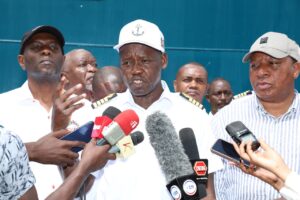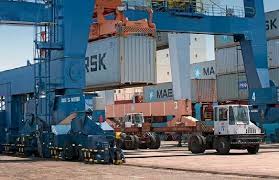Surge at Kenya’s Ports: A Testament to Growth and Opportunity

Kenya Poryts Authority clearing cargo at Mombasa Port. (Photo/ Courtesy)
By Andrew Mwangura
Email, thecoastnewspaper@gmail.com
In the next 14 days, the Port of Mombasa, Kenya’s maritime gateway, is set to buzz with unprecedented activity, handling a total of 45 vessels. This includes 27 container ships, 14 conventional cargo vessels, six car carriers, and two oil tankers. Simultaneously, the Port of Lamu, Kenya’s newer coastal hub, will manage four container vessels.
This flurry of maritime traffic signals a vibrant moment for Kenya’s economy, underlining the country’s growing role as a critical node in global trade. Yet, it also raises questions about capacity, infrastructure, and the broader implications for Kenya’s economic trajectory.
The Port of Mombasa has long been the heartbeat of Kenya’s trade ecosystem. As East Africa’s busiest port, it serves not only Kenya but also landlocked neighbors like Uganda, Rwanda, and South Sudan.
The arrival of 45 vessels in just two weeks is a testament to its enduring importance. Container ships, making up the bulk of the traffic with 27 vessels, reflect the global demand for goods ranging from consumer electronics to agricultural products.
Mombasa’s ability to handle such a volume speaks to its operational resilience, but it also highlights the pressure on its infrastructure.
The port’s efficiency in processing these ships—unloading, clearing customs, and ensuring timely onward transport—will be critical to maintaining Kenya’s reputation as a reliable trade hub.
The diversity of vessels docking at Mombasa further illustrates the port’s versatility. The 14 conventional cargo vessels, which carry bulk goods like grains, cement, or steel, point to sustained demand in construction and food supply chains. The six car carriers indicate a steady flow of vehicles, likely fueled by Kenya’s growing middle class and regional demand for automobiles.
The two oil tankers, though fewer in number, are no less significant, as they underscore Kenya’s role in facilitating energy supplies for itself and its neighbors. Together, this mix of maritime traffic paints a picture of a dynamic economy, one that is both consuming and exporting at a robust pace.
Meanwhile, the Port of Lamu, though smaller and newer, is carving out its own niche. Handling four container vessels in the same period is a notable achievement for a port still establishing itself. Lamu’s emergence complements Mombasa, easing the burden on the older port and signaling Kenya’s ambition to expand its maritime footprint.
Positioned as part of the Lamu Port-South Sudan-Ethiopia-Transport (LAPSSET) corridor, Lamu is poised to serve not only Kenya but also Ethiopia and South Sudan, fostering regional integration. Its ability to handle container vessels, even at this early stage, suggests a promising future, though its growth depends on continued investment in infrastructure and connectivity.

This surge in port activity is a microcosm of Kenya’s broader economic aspirations. The country has positioned itself as a gateway to East Africa, leveraging its strategic location along the Indian Ocean to attract global trade. The influx of vessels reflects confidence in Kenya’s stability and its ability to facilitate commerce. However, this moment of opportunity also brings challenges.
Mombasa’s port, while efficient by regional standards, has faced criticism for delays, congestion, and bureaucratic hurdles. Handling 45 vessels in two weeks will test its capacity to the limit. Any bottlenecks—whether in customs clearance, cargo handling, or inland transport—could erode the trust of shippers and traders.
Kenya cannot afford to squander this chance to solidify its place in global supply chains.
The environmental implications of this maritime boom also deserve attention.
The arrival of oil tankers, in particular, raises concerns about potential spills or pollution in Mombasa’s coastal waters, a vital ecosystem for marine life and tourism. Both Mombasa and Lamu must prioritize sustainable practices, ensuring that increased traffic does not come at the expense of the environment.
Investments in green technologies, such as cleaner fuels or electrified port equipment, could help mitigate the impact.
Kenya has an opportunity to set a regional standard for environmentally conscious port operations, balancing economic growth with ecological responsibility.
Beyond logistics and sustainability, the human element of this port activity cannot be overlooked. The influx of vessels will generate jobs, from dockworkers to customs officials to truck drivers.
These opportunities are vital in a country where unemployment remains a persistent challenge. However, the quality of these jobs matters as much as their quantity. Fair wages, safe working conditions, and opportunities for skill development must accompany this economic upswing. The Kenya Ports Authority (KPA) and private operators should ensure that the benefits of this maritime boom reach the workers who keep the ports running.
Lamu’s role, though smaller, carries its own significance. The port’s ability to handle container vessels signals its potential to decongest Mombasa and serve as a secondary hub. Yet, Lamu’s success hinges on more than just port infrastructure.
The LAPSSET corridor requires robust road and rail links to Ethiopia and South Sudan, projects that have faced delays and funding challenges. If Kenya can overcome these hurdles, Lamu could transform into a major economic engine, creating jobs and fostering trade across borders. For now, its handling of four container vessels is a modest but promising start.
This moment of intense port activity is a chance for Kenya to showcase its potential. Mombasa’s ability to manage 45 vessels efficiently will reinforce its status as East Africa’s premier port.

Lamu’s contribution, though smaller, hints at a future where Kenya’s maritime capacity is distributed more evenly, reducing strain on any single hub. Together, these ports can drive economic growth, create jobs, and strengthen regional ties.
However, success is not guaranteed. Investments in infrastructure, streamlined processes, and sustainable practices are essential to capitalize on this opportunity. Kenya stands at a crossroads, with its ports as the gateway to a brighter economic future. The next 14 days will be a critical test of its readiness to seize the opportunity.
The author is a policy analyst specializing in maritime governance and blue economy development.





